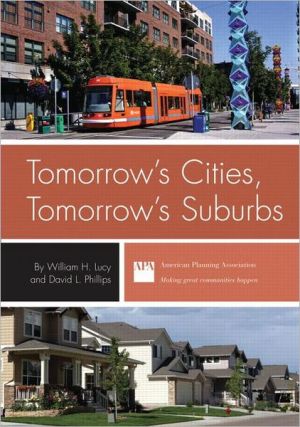

 |

|

Sold Out
Book Categories |
Preface
Acknowledgements
List of Figures
List of Tables
List of Maps
List of Acronyms
PART 1. THEMES AND POLICY APPROACHES
1. Is the Past Prologue for Change?
Disparities in Relative Income
Growth, Sprawl, and Disparities
Housing Markets, Mobility, and Federal Policies
Consumerism and Careerism
Local Government Development Decisions
Tyranny of Easy Development Decisions
Beliefs and Public Policies
Order of Chapters
Beliefs and Practice
2. Too Little Housing in Policy Critiques
Land Consumption
Poverty Concentrations
Taxable Resource Inequalities
Racial Segregation in Suburbs
Market Tests and Spatial Inequalities
Proposed Remedies
Mega-Decisions and Daily Life
Decisions and Small-Scale Policies
PART II. CITIES AND SUBURBS: TRENDS AND INTERPRETATIONS
3. Exaggerating City Population Decline
Twentieth-Century Trends
Population and Occupied Housing Changes
Cities' Evolution from 1950 to 1970
Downtown Population Changes
Racial Change
Population and Housing in 50 States
Variation by Size and Region
Immigration
Beliefs and Preferences
Demand Increased
4. Housing and Cities' Prospects
Summary of Findings
The Relative Income Measure
Disparities between Cities and Suburbs
542 Cities
Region and Population
Nonstable Cities
White Flight?
Home Ownership
Relative Income in Six Central Cities
Poverty in Cities
Concentrated Neighborhood Poverty
Single-Unit Structures and Home Ownership
Single-Unit Structures and Relative Income
Small Houses, Ownership,and Relative Income
Condominiums
Housing Past and Future
Post-2000 Trends in Cities
5. Scoping Suburban Decline
Summary of Results
Suburban Dominance
City Decline and Metropolitan Growth
Ring, Sector, and Scattered Population Decline
Population Size in Suburbs
Severe Suburban Population Loss
Prospects for Increasing Density
Suburban Density
Immigrants
Suburban Decline in the 1960s and 1970s
Average Household Size, Families with Children, and the Elderly
High Elderly Populations
Average Household Size and Occupied Housing Units
Suburban Trends
Methods
6. Discovering Poor Suburbs
Summary of Findings
Methodology
Relative Income Conditions and Trends
Regions and Growth Matter Little
Spatial Patterns
Growing Suburbs and Metropolitan Areas
Population Size and Income Changes
City and Suburb Incomes
The Lowest Relative Income Suburbs
Poverty in Suburbs
Poverty in Suburban Neighborhoods
Income Changes in the 1980s and 1990s
Decline in Old and Middle-Aged Suburbs
Volatility in Suburbs
Suburban Income Change Variations
Metropolitan Profiles of Income Changes
Summary and Interpretation
7. Do Middle-Aged Suburbs Need to Reinvent Themselves?b
Summary of Findings
Three Theories: Population, Contagion, and Age of Housing
Methodology
Describing and Explaining Income Transitions
Scale and Time
Decade of Housing Construction and Relative Income Changes
Factors in Differentiating Neighborhoods
Interpretation
8. Discovering Virtues of Old Neighborhoods
Units of Analysis
Relative Income and Decade of Construction
Neighborhood Life Cycles
Income Increases in Neighborhoods in the 1980s and 1990s
Evidence for Trickle-Down Neighborhood Change
Counting Census Tracts
Comparing the 1990s and 1980s
Which Old Neighborhoods Increased in Relative Income
Differences among Metropolitan Areas
Summary of Trends
Impending Suburban Triumph from a 1950 Perspective
PART III. BELIEFS AND PLACES
9. Linking Patterns, Beliefs, and Policies
A Policy Debate about Trickle-Down Neighborhood Change
Influences on Preferences
Conditions and Ideas Influence Beliefs and Actions
Consumer Preferences for Neighborhood Settings
Crime Rates Fell in the 1990s
Beliefs about Health and Motor Vehicle Safety
Demography Alters the Distribution of Location Preferences
Results Matter
Myths and Mega-Decisions
10. The Cul-de-Sac Safety Myth: Housing Markets and Settlement Patterns
The Issue
History
Effects of Street Networks on Safety
11. The Myth of Exurban Safety and Rational Location Decisions
Comparative Danger
Homicides, Violent Crime, and Traffic Fatalities
Low Density, Speed, and Traffic Deaths
Homicides by Family Members, Acquaintances, and Strangers
Traffic Fatality Rates in Cities, Suburbs, and Exurbs
Narrow Roads and Aggressive Driving
Awareness of Dangers
Misinformation, Miscalculations, and misdirected Emotions
Danger of Leaving Home
Fear of Crime
Sex, Insurance, and Traffic Information
12. The Past and Future of Small House Neighborhoods
Contemporary "Happy" Residence Beliefs
New House Profiles
Why Small House Expansion and Adaptation is Difficult
Why the Suburbs' Mid-Life Crisis May Get Worse
Institutions and Finance
A Case Study of Problems, Opportunities, and Policies
Relative Income and Family Poverty
Reversal of Neighborhood Trends and Age of Housing
Henrico's 60 Census Tracts
What Happened in Small House Neighborhoods?
Henrico's Public Policy Responses
Central City Versus Suburban Prospects
13. Can Local Policies Make a Difference?
Downtown Revival Despite Sprawl
Charlottesville's Downtown Revival and Beyond
Transit-Oriented Development
Arlington and Alexandria
Middle-Class Location Decisions and Small Houses
Chicago's Historic Bungalows
Single-Unit Dwellings
Condominiums Increase Ownership
Enhancing Decentralized Decisions
Investments Decisions
14. Prospects for Stability and Revival
Variation and Uncertainty
Regionalism
Beliefs Relevant to Location Decisions
Beliefs, Roles, and Policies
Markets and Decentralized Decisions
Where Next?
Index
Login|Complaints|Blog|Games|Digital Media|Souls|Obituary|Contact Us|FAQ
CAN'T FIND WHAT YOU'RE LOOKING FOR? CLICK HERE!!! X
 You must be logged in to add to WishlistX
 This item is in your Wish ListX
 This item is in your CollectionTomorrow's Cities, Tomorrow's Suburbs
X
 This Item is in Your InventoryTomorrow's Cities, Tomorrow's Suburbs
X
 You must be logged in to review the productsX
 X
 X

Add Tomorrow's Cities, Tomorrow's Suburbs, Cities ruled the first half of the 20th century; the second half belonged to the suburbs. Will cities become dominant again? Can the recent decline of many suburbs be slowed? 'Tomorrow's Cities, Tomorrow's Suburbs' predicts a surprising outcome in the dec, Tomorrow's Cities, Tomorrow's Suburbs to the inventory that you are selling on WonderClubX
 X

Add Tomorrow's Cities, Tomorrow's Suburbs, Cities ruled the first half of the 20th century; the second half belonged to the suburbs. Will cities become dominant again? Can the recent decline of many suburbs be slowed? 'Tomorrow's Cities, Tomorrow's Suburbs' predicts a surprising outcome in the dec, Tomorrow's Cities, Tomorrow's Suburbs to your collection on WonderClub |